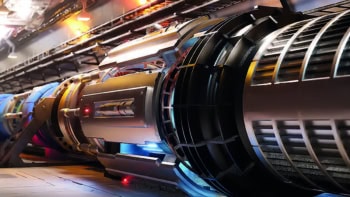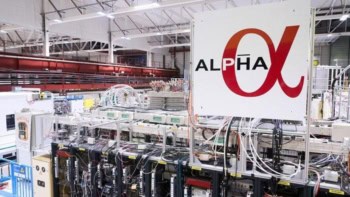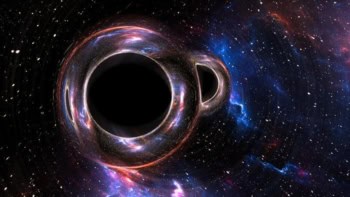
A new experiment has offered the clearest view yet of how gluons behave inside atomic nuclei. Conducted at the Thomas Jefferson National Accelerator Facility in the US, the study focused on a rare process called photoproduction. This involves high-energy photons interacting with protons confined in nuclei to produce J/psi mesons. The research sheds light on how gluons are distributed in nuclear matter and is a crucial step toward understanding the nature of protons within nuclei.
While gluons are responsible for generating most of the visible mass in the universe, their role inside nuclei remains poorly understood. These massless particles mediate the strong nuclear force, which binds quarks as well as protons and neutrons in nuclei. Gluons carry no electric charge and cannot be directly detected.
The theory that describes gluons is called quantum chromodynamics (QCD) and it is notoriously complex and difficult to test – especially in the dense, strongly interacting environment of a nucleus. That makes precision experiments essential for revealing how matter is held together at the deepest level.
Probing gluons with light
The Jefferson Lab experiment focused on photoproduction, a process in which a high-energy photon strikes a particle and creates something new, in this case, a J/psi meson.
The J/psi comprises a charm quark and its antiquark and is especially useful for studying gluons. Charm quarks are much heavier than those found in ordinary matter and are not present in protons or neutrons. Therefore, they must be created entirely during the interaction, making the J/psi a particularly clean and sensitive probe of gluon behaviour inside nuclei.
Earlier studies had observed this process using free protons. This new experiment extends the approach to protons confined in nuclei to see how that environment affects gluon behaviour. The modification of quarks inside nuclei has been known since the 1980s and is called the EMC effect. However, much less is known about how gluons behave under the same conditions.
“Protons and neutrons do behave differently when they are bound inside nuclei than they do on their own,” says Jackson Pybus, now a postdoctoral fellow at Los Alamos National Laboratory and one of the experiment’s collaborators. “The nuclear physics community is still trying to work out the mechanisms behind the EMC effect. Until now, the distribution of high-momentum gluons in nuclei has remained an unexplored area.”
Pybus and colleagues used Jefferson Lab’s Experimental Hall D, which delivers an intense beam of high-energy photons. This setup had previously been used to study simpler systems, but this was the first time it was applied to heavier nuclei.
“This study looked for events where a photon strikes a proton inside the nucleus to knock it out while producing a J/psi,” Pybus explains. “By measuring the knocked-out proton, the produced J/psi, and the energy of the photon, we can reconstruct the reaction and learn how the gluons were behaving inside the nucleus.” This was done using the GlueX spectrometer.
Unexpected signals
Significantly, the experiment was accessing the “threshold” region – where the photon has just enough energy to produce a J/psi meson. Near-threshold interactions are particularly valuable because they are highly sensitive to the gluon structure of the target. Creating a heavy charm-anticharm pair requires a large energy transfer so interactions in this region reveal how gluons behave when little momentum is available. This is a regime where theoretical uncertainties in QCD are especially large.
Even more striking were the observations below this threshold. In so-called “sub-threshold” photoproduction, the incoming photon does not carry enough energy to produce the J/psi on its own, so it must draw additional energy from the internal motion of protons or from the nuclear medium itself. This is a well-understood mechanism in principle, but the rate at which it occurred in the experiment came as a surprise.
“Our study was the first to measure J/psi photoproduction from nuclei in the threshold region,” Pybus said. “The data indicate that the J/psi is produced more commonly than expected from protons that are moving with large momentum inside the nucleus, suggesting that these fast-moving protons could experience significant distortion to their internal gluons.”
The sub-threshold results were even harder to explain. “The number of subthreshold J/psi exceeded expectations,” Pybus added. “That raises questions about how the photon is able to pick up so much energy from the nucleus.”
Towards a deeper theory
The results suggest that gluons may be modified inside nuclei in ways that are not described by existing models – suggesting a new frontier in nuclear physics.
“This study has given us the first look at this sort of rare phenomenon that can teach us about the gluon inside the nucleus – just enough data to point to unexpected behaviours,” said Pybus. “Now that we know this measurement is possible, and that there are signs of interesting and unexplored phenomena, we’d like to perform a dedicated measurement focused on pinning down the sort of exotic effects we’re just now glimpsing.”
Follow-up experiments, including those planned at the future Electron-Ion Collider, are expected to build on these results. For now, this first glimpse at gluons in nuclei reveals that even decades after QCD’s development, the inner workings of nuclear matter remain only partially illuminated.
The research is described in Physical Review Letters.



